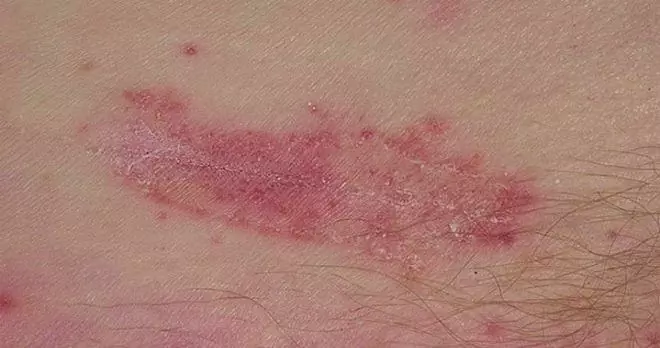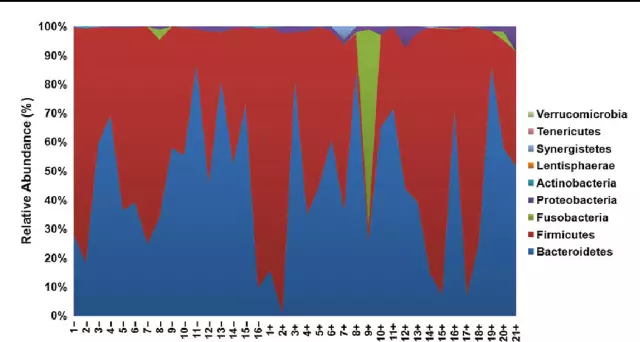- Author Rachel Wainwright [email protected].
- Public 2023-12-15 07:39.
- Last modified 2025-11-02 20:14.
Intestinal candidiasis
The content of the article:
- Forms of the disease
- Causes and risk factors
- Intestinal candidiasis symptoms
- Diagnostics
- Intestinal candidiasis treatment
- Diet for intestinal candidiasis
- Potential consequences and complications
- Forecast
- Prevention
Intestinal candidiasis is an infection of the mucous membrane of the intestinal tract caused by opportunistic fungi belonging to the genus Candida. The disease is quite difficult to diagnose, since about 80% of healthy adults have Candida in their intestines. With a normally functioning immune system, intestinal candidiasis in children and adults does not develop. In fact, this pathology is a variant of an opportunistic infection developing against the background of immunodeficiency.

Intestinal candidiasis is caused by conditionally pathogenic fungi of the genus Candida
Forms of the disease
The following forms of intestinal candidiasis are distinguished:
- Non-invasive. Against the background of dysbiosis, fungi of the genus Candida begin to actively multiply in the intestinal lumen, without penetrating into the thickness of the intestinal wall. In the process of vital activity, fungi secrete specific toxins that irritate the intestinal mucosa. Under the influence of fungal toxins, the imbalance of the intestinal microflora is aggravated, mycotic (fungal) allergy is formed and secondary immunodeficiency develops.
- Invasive, or visceral. Formed against the background of severe immunodeficiency. In this form of the disease, Candida fungi attach to the cells of the squamous stratified epithelium, then transform into a filamentous form and penetrate into the intestinal wall. From here, the fungi spread through the bloodstream throughout the body, affecting the pancreas, liver and other organs. This form is usually seen in patients with advanced AIDS or severe neutropenia (almost complete absence of neutrophils in the blood).
- Focal. This is a secondary candidiasis that develops against the background of a duodenal ulcer, ulcerative colitis.
Causes and risk factors
The causative agent of intestinal candidiasis is Candida fungi (most often Candida albicans), belonging to opportunistic microflora. They are present in the body of most people, but they do not cause any pathologies. Only against the background of a significant decrease in immunity is the fungal infection activated, leading to the development of the disease.

Fungal infection is activated against the background of decreased immunity
A necessary condition for the development of intestinal candidiasis is the presence of at least one of the following factors:
- congenital immunodeficiency (Neselof, Di Giorgi syndromes);
- physiological weakening of immunity (pregnancy, severe stress, old age, neonatal period);
- oncological diseases, especially against the background of chemotherapy;
- allergic and autoimmune diseases, which are treated with corticosteroids;
- immunosuppressive therapy after organ transplantation;
- severe pathologies of the endocrine system;
- intensive therapy of somatic diseases;
- long-term antibiotic therapy with reserve drugs;
- improper diet (lack of vitamins and protein in the diet);
- primary immunodeficiency syndrome.
With a normally functioning immune system, intestinal candidiasis in children and adults does not develop. In fact, this pathology is a variant of an opportunistic infection developing against the background of immunodeficiency
In most cases, a combination of two or more risk factors leads to the development of intestinal candidiasis.
Intestinal candidiasis symptoms
Signs of intestinal candidiasis are determined by the clinical form of the disease. With an invasive (widespread) process, the condition is severe, due to severe intoxication. The main symptoms of intestinal candidiasis in this case are:
- increased body temperature;
- intense pain in the abdomen;
- diarrhea with blood in the stool.

Intense abdominal pain, diarrhea - the main symptoms of intestinal candidiasis
In cases where a fungal infection spreads, signs of damage to internal organs (gallbladder, spleen, pancreas or liver) appear.
Diffuse invasive bowel candidiasis is almost never seen in people with normal immunity. As a rule, the disease occurs as a complication of severe diabetes mellitus, malignant lesions of the blood or AIDS (it may be its debut).
With a protracted course of ulcerative colitis or duodenal ulcer, one can assume the presence of focal invasive intestinal candidiasis. In this type of mycosis, the fungi turn into a filamentous form and penetrate into the intestinal wall in the area of ulcerative defects. In other parts of the intestine, drusen (dense grains formed by filaments of mycelium) of fungi are not found. Direct signs of intestinal candidiasis may be absent, in this case the disease is diagnosed by chance, during the histological analysis of a biopsy of the intestinal wall in the area of the ulcer. In other situations, focal candidiasis is manifested by an intestinal disorder resembling food intoxication, and an admixture of blood in the feces.
In clinical practice, non-invasive intestinal candidiasis is most often observed, in which the pathogen intensively multiplies in its lumen, while releasing a significant amount of specific fungal metabolites. These metabolites have both general resorptive and local toxic effects on the patient's body. Medical statistics show that about 35% of cases in the general structure of intestinal dysbiosis are non-invasive candidiasis.
With this form of mycosis, the general condition of the patients remains satisfactory, the symptoms of intoxication are weak or moderate. Unstable stools, flatulence, and abdominal discomfort are often noted. Against the background of non-invasive intestinal candidiasis, the body becomes allergic, which contributes to the emergence or exacerbation of already existing allergic diseases. Clinicians often refer to this form of candidiasis as irritable bowel syndrome.
Diagnostics
As already noted, the diagnosis of intestinal candidiasis in children and adults presents significant difficulties, which is explained by the following factors:
- the absence in the clinical picture of the disease of specific symptoms of mycotic intestinal lesions;
- lack of sufficiently sensitive and specific methods of laboratory diagnostics, allowing to isolate fungi of the genus Candida in feces and biopsies.
A general blood test for this pathology is uninformative. It can reveal anemia, erythrocytopenia, leukocytopenia, lymphocytopenia.
If intestinal candidiasis is suspected, the patient should be referred for endoscopic examination, during which nonspecific signs of mucosal inflammation are detected. For non-invasive intestinal candidiasis, catarrhal inflammation is characteristic, and for invasive diffuse - ulcerative-necrotic lesion of the mucous membrane. During endoscopy, a biopsy is performed, followed by histological and cultural examination of the obtained biopsies. The results are often false negative, since not all samples are able to obtain pseudomycelium of fungi.

If intestinal candidiasis is suspected, the patient is referred for endoscopic examination
If intestinal candidiasis is suspected, a bacteriological examination of feces and seeding of feces for dysbiosis are prescribed. Usually, these analyzes reveal mixed flora (fungi, staphylococci, Klebsiella, E. coli). With candidiasis in 1 g of feces, less than 1,000 colony-forming units are detected, but if their number exceeds 1,000 units, this is a sign of intestinal candidiasis.
Cultural research allows not only to establish the type of causative agent of the disease, but also to determine its sensitivity to antifungal agents.
To make a diagnosis, the patient must have three diagnostic criteria at the same time:
- Detection of Candida fungi in feces during culture studies;
- Identification of endoscopic signs of intestinal candidiasis;
- The presence of at least one risk factor for the development of the disease.
A single detection of Candida fungi in feces is not a basis for diagnosing a patient with intestinal candidiasis and prescribing antifungal therapy.
Intestinal candidiasis treatment
Intestinal candidiasis is treated by a gastroenterologist. It includes the following areas:
- correction of the patient's immune status;
- combating fungal infection by prescribing antifungal agents;
- treatment of the underlying disease, which caused a decrease in immunity and led to the activation of Candida fungi.
Invasive forms of intestinal candidiasis are an indication for hospitalization. Drug therapy is carried out with antifungal drugs, which are well absorbed from the gastrointestinal tract and have not only local, but also systemic effects.

Improving immunity is an indispensable component of the treatment of intestinal candidiasis
Specific treatment of patients with non-invasive forms of intestinal candidiasis is carried out with non-resorptive antimycotics. They are practically not absorbed by the mucous membrane and therefore a high concentration of the active substance is created in the intestinal lumen. Other benefits of nonresorptive antimycotics are:
- lack of addiction;
- low risk of side effects;
- no negative impact on the normal intestinal microflora.
Considering that mixed flora and dysbiosis play an important role in the pathological mechanism of development of non-invasive intestinal candidiasis, it is recommended to take eubiotics and antimicrobial drugs.
Symptomatic treatment of intestinal candidiasis includes the use of analgesic, antispasmodic drugs, sorbents and digestive enzymes according to indications.
Diet for intestinal candidiasis
In the complex therapy of intestinal candidiasis, diet plays an important role. Patients are advised to refuse or significantly limit the content of light carbohydrates in the diet, since they are an excellent breeding ground for Candida fungi. Excluded from the menu:
- sweet fruits;
- industrially prepared juices;
- sweet carbonated drinks;
- pasta and other flour products;
- kvass, beer and alcohol;
- sugar, confectionery, jam, honey.

With intestinal candidiasis, patients are shown a special diet
The menu is based on the predominant use of the following products:
- lean meat and fish;
- eggs;
- vegetables with a low starch content (spinach, beans, cabbage and cauliflower, cucumbers, zucchini, bell peppers);
- Fruits that are low in carbohydrates, such as sour apples
- fermented milk products (fermented baked milk, yogurt, yogurt, kefir, cottage cheese).
Potential consequences and complications
Complications of intestinal candidiasis can be:
- intestinal perforation;
- intestinal bleeding;
- damage to parenchymal organs (pancreas, liver, gallbladder);
- development of fungal sepsis.
Forecast
With invasive diffuse intestinal candidiasis, the prognosis for life is serious, the mortality rate ranges from 25 to 55%. Non-invasive candidiasis with timely started and actively carried out therapy in most cases ends with full recovery.
Prevention
In order to prevent intestinal candidiasis, it is necessary to eliminate factors predisposing to the development of intestinal dysbiosis. This requires:
- adhere to a balanced diet (in the diet they limit light carbohydrates, increase the content of fresh vegetables, fruits, fermented milk products);
- abandon the uncontrolled use of antibiotics;
- timely identify and actively treat diseases of the gastrointestinal tract.
Patients at risk for the development of intestinal candidiasis (therapy with corticosteroids, polychemotherapy, severe diseases of the endocrine system, HIV infection) should be under close medical supervision and regularly be examined for fungal infection.
YouTube video related to the article:

Elena Minkina Doctor anesthesiologist-resuscitator About the author
Education: graduated from the Tashkent State Medical Institute, specializing in general medicine in 1991. Repeatedly passed refresher courses.
Work experience: anesthesiologist-resuscitator of the city maternity complex, resuscitator of the hemodialysis department.
The information is generalized and provided for informational purposes only. At the first sign of illness, see your doctor. Self-medication is hazardous to health!






